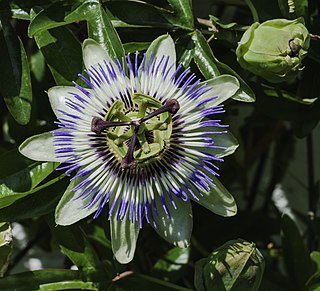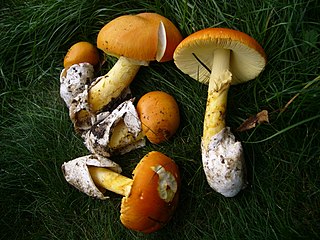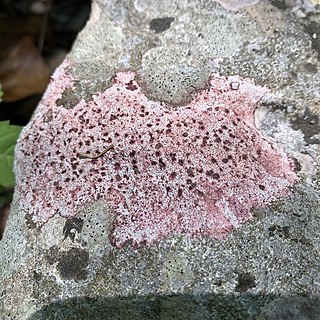
Giovanni Antonio Scopoli was an Italian physician and naturalist. His biographer Otto Guglia named him the "first anational European" and the "Linnaeus of the Austrian Empire".

Passiflora caerulea, the blue passionflower, bluecrown passionflower or common passion flower, is a species of flowering plant native to South America. It has been introduced elsewhere. It is a vigorous, deciduous or semi-evergreen tendril vine growing to 10 m (33 ft) or more. Its leaves are palmate, and its fragrant flowers are blue-white with a prominent fringe of coronal filaments in bands of blue, white, yellow, and brown. The ovoid orange fruit, growing to 6 cm (2 in), is edible, but is variously described as having a bland, undesirable, or insipid taste. In South America, the plant is known for its medicinal properties, and is used by both the Toba and the Maka peoples.

Amanita caesarea, commonly known as Caesar's mushroom, is a highly regarded edible mushroom in the genus Amanita, native to southern Europe and North Africa. While it was first described by Giovanni Antonio Scopoli in 1772, this mushroom was a known favorite of early rulers of the Roman Empire.

The blue petrel is a small seabird in the shearwater and petrel family, Procellariidae. This small petrel is the only member of the genus Halobaena, but is closely allied to the prions. It is distributed across the Southern Ocean but breeds at a few island sites, all close to the Antarctic Convergence zone.

Macrolepiota procera, the parasol mushroom, is a basidiomycete fungus with a large, prominent fruiting body resembling a parasol. It is a fairly common species on well-drained soils. It is found solitary or in groups and fairy rings in pastures and occasionally in woodland. It is widespread in temperate regions of Eurasia and possibly North America. Further research is needed to confirm whether specimens found in North America are the same species.

The blue whistling thrush is a bird in the Old World flycatchers family Muscicapidae that is found in the mountains of Central Asia, South Asia, China and Southeast Asia. It is known for its loud human-like whistling song at dawn and dusk. The widely distributed populations show variations in size and plumage with several of them considered as subspecies. Like others in the genus, they feed on the ground, often along streams and in damp places foraging for snails, crabs, fruits and insects.
Cholius is a genus of moths of the family Crambidae.

Sesleria is a genus of perennial plants in the grass family. They are native to Eurasia and North Africa. They are found in Albania, Austria, Baleares, Baltic States, Belarus, Belgium, Bulgaria, Corsica, Czechoslovakia, East Aegean Islands, Finland, France, Germany, Great Britain, Greece, Hungary, Iceland, Iran, Ireland, Italy, Crete, Crimea, Lebanon, Morocco, North Caucasus, Poland, Romania, Sardina, Sicilia, Spain, Sweden, Switzerland, Syria, Transcaucasus, Turkey, Ukraine and Yugoslavia.

Nycteola revayana, the oak nycteoline, is a moth of the family Nolidae. The species was first described by Giovanni Antonio Scopoli in 1772. It is found from Europe and east across the Palearctic to Japan and India.

Opsilia coerulescens is a gray coloured species of a beetle from family longhorn beetle, subfamily Lamiinae.

Opsilia is a genus of beetles in the family Cerambycidae. It is listed as a subgenus of Phytoecia by some sources.

Saperda is a genus of flat-faced longhorn beetles belonging to the family Cerambycidae, subfamily Lamiinae. The genus was erected by Johan Christian Fabricius in 1775.

Oreina is a genus of broad-shouldered leaf beetles belonging to the family Chrysomelidae, subfamily Chrysomelinae.

Cicadetta montana is a species of Cicadetta found throughout Europe and in parts of Asia.

Heterotoma is a genus of bug from Miridae family.

Phytoecia is a genus of longhorn beetles of the subfamily Lamiinae,

Phytoecia caerulescens is a species of beetle in the family Cerambycidae. It was described by Scopoli in 1763, originally under the genus Leptura. It has a wide distribution in Europe, and has been introduced into Australia. It feeds on Echium vulgare, Lappula squarrosa, Anchusa officinalis, Lithospermum officinale, and Cynoglossum officinale.

Plateumaris braccata is a species of leaf beetle from the Donaciinae subfamily which can be found in the western part of the Palearctic region, from Spain to Central Asia.

Vulpicida pinastri is a species of foliose lichen in the family Parmeliaceae. The lichen has a greenish-yellow thallus and dorsiventral lobes. It grows on conifers and Betula in North America and Eurasia. It is the only sorediate species in the genus and is distinguished by the bright-yellow marginal soralia. The lichen, originally described by Italian naturalist Giovanni Antonio Scopoli in 1772, was transferred to the newly circumscribed genus Vulpicida by Jan-Eric Mattson and Ming-Jou Lai in 1993.

Bagliettoa marmorea is a species of saxicolous (rock-dwelling), crustose lichen in the family Verrucariaceae. It is endolithic on calcareous rocks, meaning it grows under and around the rock crystals. The colour of the lichen is purple to pink, although sometimes it is grey with purple pigments visible only around the perithecia. It does not have a shield-shaped involucrellum, which is typical of several other species in genus Bagliettoa. The excipulum measures 0.2–0.3 mm in diameter and lacks colour other than the upper part, which is purple. Ascospores are 13–30 by 9–15 μm.

















